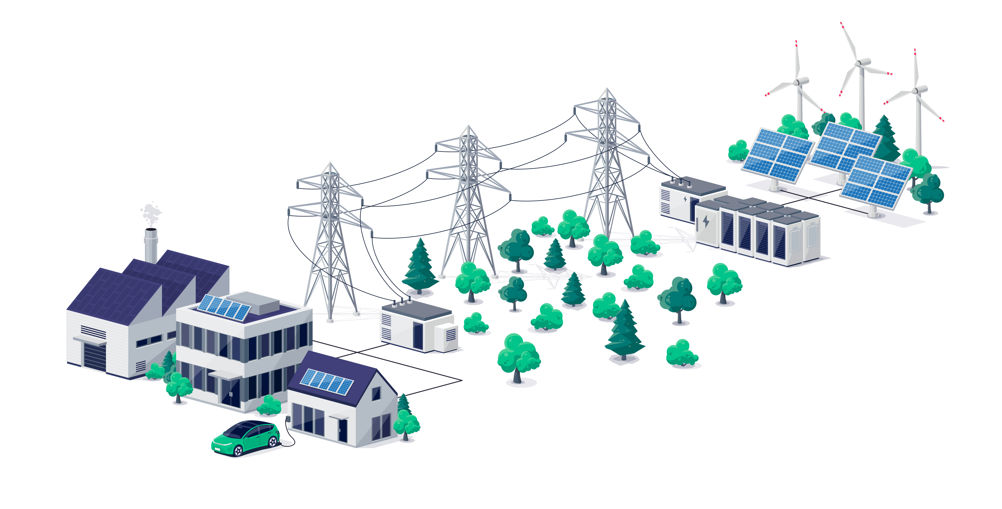To meet the government’s target and load growth on the distribution network, industry must deliver more than five times the amount of electricity transmission infrastructure in the next seven years - over what has been built in the past 30 years.
An ambitious and challenging target for National Grid.
POLL FINDS SUPPORT FOR NEW ELECTRICITY GRID INFRASTRUCTURE
However, with up to a 15-year wait period for a connection, commentators warn this could hold back billions in green investment, threatening to derail the UK’s progress towards climate targets. National Grid will tell developers to “get on, get back or get out of the energy queue”.
Big plans on investment for future connections see around 80GW of contracted generation already in place. By 2034, there’s plans for 300GW to be built. Given the historic conversion rate is around 15-20 per cent, this leaves most connection contracts unbuilt and soaking up contracted connection capacity.
The fallout will slow the process for everyone further down the line in the built environment. Then again, all is not how it seems. The clue lies in the phrase ‘contracted capacity.’ What does this mean for connections at the distribution level where developers would operate?
The good news is the network is contractually full, not physically full.
There’s available capacity within the network with quick fixes that could ensure no self-driven panic across green energy project promoters and developers. Despite fears that London has run out of capacity and developers are struggling to obtain new connection agreements, the reality is that the network is only running at 60 per cent capacity, according to UKPN.
It’s reminiscent of holidaymakers throwing towels on sun loungers when the pool opens, but not coming to claim them until later - or at all.
Reserving a lounger, you’re unlikely to use, like contracted capacity for a project unlikely to move forward, takes opportunity away from others. This results in more sun loungers being ordered when there is already enough to go around.
Here’s my five-point plan on how to combat this.
Amnesty
Let’s cut the queue. Today, offers made are conditional with set requirements. Many long-term offers that haven’t moved forward are likely to breach these conditions. The DNOs appear to be ignoring potential Connection Agreement breaches and the opportunity to cancel the connection contract legitimately. Why doesn’t it happen now? Lack of resources and behaviours not set up to review these conditions on a regular basis. The problem is, DNOs can’t admit to either, without risk of being penalised by the regulator. If the DNOs suddenly cut the queue of those in breach of contract now, it would raise the question why has this not been done already and risk penalisation.
The answer? Amnesty. A period put in place pulling those in breach from the queue. We need a pragmatic pathway for DNOs to filter out the noise.
Legal levers
Power companies have a legal obligation to make a developer or promoter an offer of a connection that is ‘capable of acceptance’ – at least it would be if it weren’t for the 15-year wait. A lot can happen in 15 years, including the business case itself becoming invalid. Power companies could be in breach of their licence by making such long term offers for a connection.
However, if the DNOs were in fear of being sued, they might just find the resources and motivation to make connection lead times ‘capable of acceptance.’ There’s currently no pressure on these timescales - what the DNO says, goes. We need to challenge this and understand how they’re derived in the first place. Then, developments looking for connections on the low-voltage level can proceed, meaning more houses, businesses, and office developments.
Developer guesswork
The fear of not enough capacity in the network creates a ‘just in case’ mindset. Developers are jumping in to secure future capacity but what they ask for varies, consuming it for other legitimate needs.
DNOs must allocate the capacity requested, regardless of when it’s required. Often, developers don’t get the right advice on the real required load. Better checks on loads will help with realistic planning. These requirements can be matched with existing capacity, getting projects off the ground quicker.

Developers need an advisor who knows how to calculate and not just implement a contingency plan. Open dialogue is essential between DNOs and developers for an improvement to be achieved once capacity is ‘freed up.’
Diversity
Every household item has its own capacity requirement. Run at the same time will overload said capacity and the 100 Amp fuse would trip. Why 100 Amp fuse? Because you’re unlikely to need more than this at one time.
Project designers add up the total development capacity with little regard for diversity of supply and demand. Those with an EV won’t charge it at 7kW all day long in a car park when it’s cheaper to run from home on a domestic tariff at night.
Phasing
A DNO is obliged to make the full requested connection capacity available to the developer from day one, but it is not needed all at once. For example, a housing development for 5,000 homes won’t have 5,000 homes needing power straight away. If the contracted capacity were phased alongside the growth of projects, it would free up capacity for others to use.
Summary
We are stuck in our ways when it comes to best practices. Change is hard to make when DNOs are highly regulated and want to avoid unnecessary risk, but it leaves no room for improvements that will help unlock the capacity conundrum.
Bottom line? There’s physical capacity, not contracted capacity. It’s been swallowed by developers out in force throwing towels on sun loungers they have no intention of using right away.
Decarbonisation requires more electricity that needs infrastructure support. The existing infrastructure in place was not intended to be forever.
For this, everyone has a part to play…
DNOs - take off the towels for projects not coming back to the pool.
Ofgem - give DNOs the space to do that without being penalised.
Developers – get good advice on the capacity you really need and don’t sit on it.

Chris Glover is Director for Total Utilities Management at Buro Happold


Hard hat mounted air curtain adds layer of protection
Something similar was used by miners decades ago!